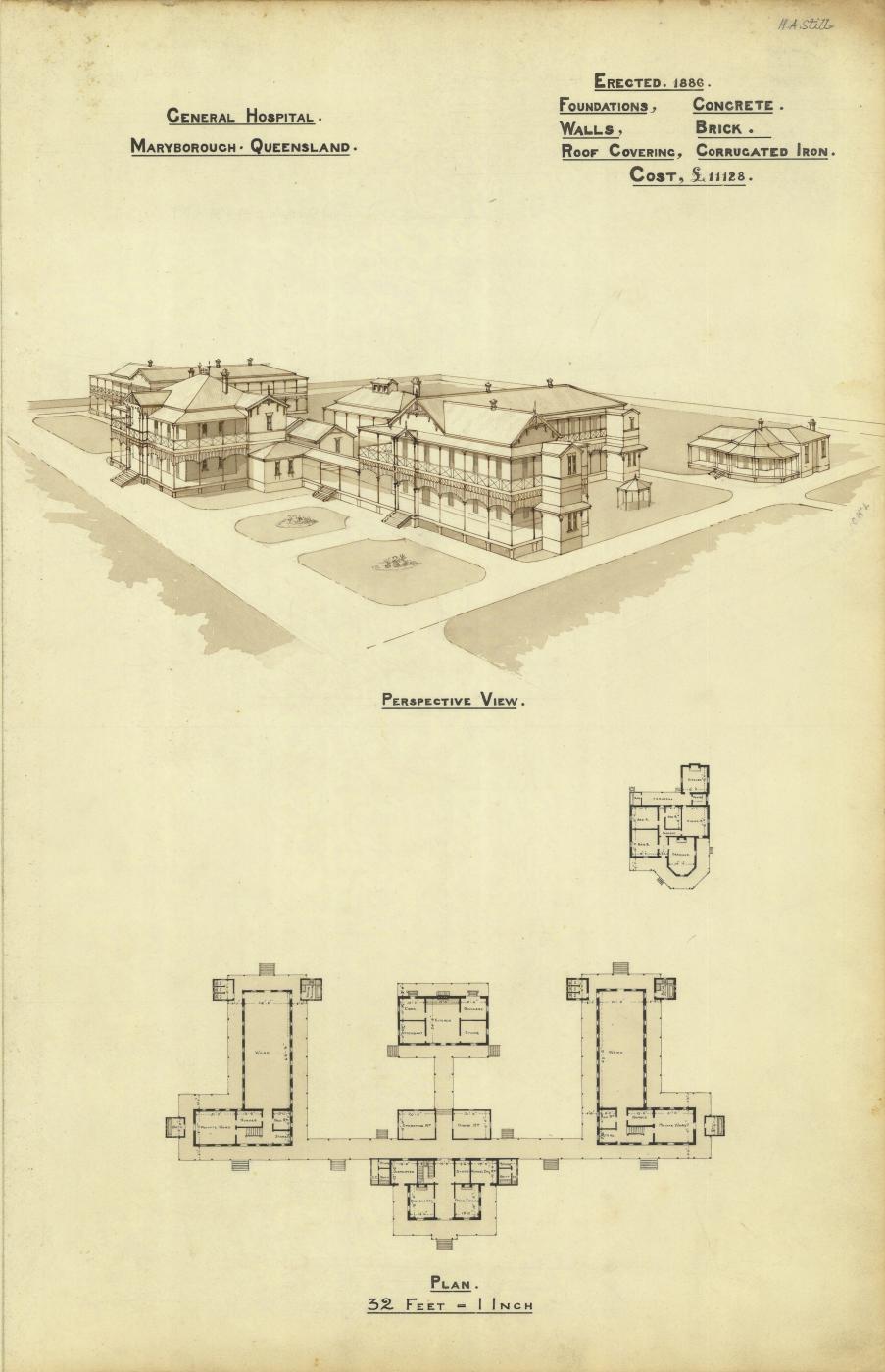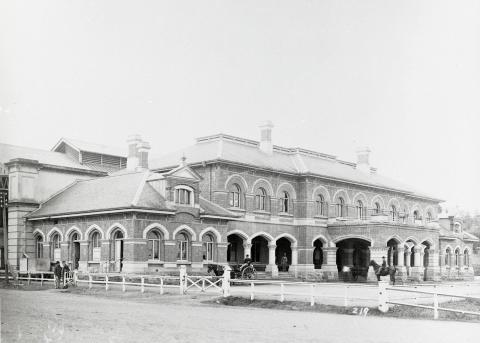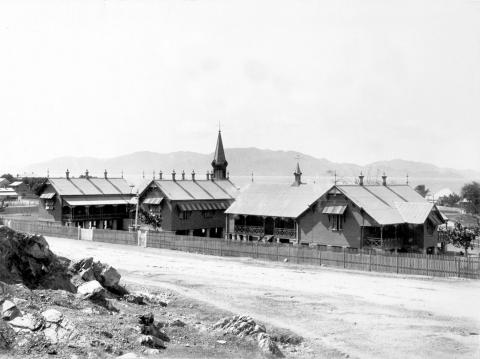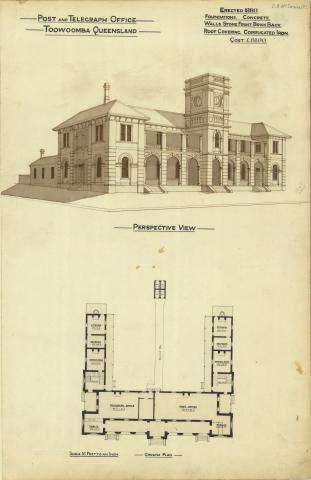
- News of the day
-
Maryborough Chronicle, Wide Bay and Burnett Advertiser, Wednesday 8 August 1945, page 5
MARYBOROUGH TO BE A BASE HOSPITAL FOR WIDE BAY
The present General Hospital at Maryborough is to be the foundation of a future base hospital for this district. The general programme of hospital improvements was outlined to a representative of this journal yesterday by the Minister for Health and Home Affairs, Mr. T. A. Foley.
Mr. Foley, who had arrived in Maryborough on Monday evening, visited the General Hospital yesterday morning. He was accompanied by Mr. H. Collins, State member for Cook, Mr. R. H. Robinson. permanent Under-Secretary to the Department of Health and Home Affairs, and Mr. D. Farrell, M.L.A. for Maryborough.
Seen subsequently, the Minister and he agreed with the Hospitals Board that the present General Hospital buildings were spread out too much for economical working. The time had arrived when consideration was to be given to modern hospital accommodation for Maryborough. The board had already consulted with one of the best hospital architects. It envisaged a ten-years plan, estimated at £250,000 lo be implemented in progressive stages.
PROGRESSIVE STAGES
“One of the first moves to meet the requirement of the existing set-up,” said Mr. Foley, “will be to build a new kitchen approximately 50 feet from the present site, in a more central position, and to modern standards.
“The first move of the new ten-years plan will be a storied building to embrace the X-ray, pathology. and out-patients departments and office administration staff on the ground floor. There will be a male and female public ward to accommodate 150 on the first floor. On the second floor there will be the maternity ward, with at least 50 beds, and private wards for general hospital patients with 100 beds. The architect is now working out a draft set of plans for submission to the board. The present Demaine ward will eventually become the nurses' quarters. The scheme will be developed thereafter as the architects, Messrs. O'Donohue and Fulton, Brisbane, plan it. The Minister explained that Maryborough had been declared a base for the Wide Bay region, which embraced a population of 110,000 people, and which already had accommodation for a thousand patients.
“The object,” he said, “is to provide medical specialists to meet the needs of the community, and eventually to give a service equal to that of the capital cities. It will thereby do away with the need to travel at. the expense of patients to the existing specialist service in the metropolitan areas.
“There will be provision, as time goes on, for the interchange, as it were, of specialists so that the people of Gympie and Bundaberg will not be at a disadvantage as compared with the people in the main base centre.”
Speaking of his visit of inspection to the Maryborough General Hospital yesterday morning, Mr. Foley said: "I was very favourably impressed with the service which the hospital staff is giving, considering the difficult conditions under which they are working in such a wide spread of the existing wards. Most of the patients I spoke to were quite pleased with the service that is given by the hospital authorities medical, nursing, ambulance and domestic staffs. There appears to be splendid co-operation and team work being practised to provide this service.”
PROVISION FOR THE AGED
“Apart from the hospital,” said Mr. Foley, “there is also the question of providing for the aged and infirm. We have already inspected some sites that are available within reasonable proximity to the hospital. and as times go on there will be some development in the provision of services for aged people.
“The Government has definite plans for the provision of suitable institutions, quite apart from Dunwich which serves the Brisbane area, the new £80,000 institution about to be erected at Rockhampton and the Eventide Home at Charters Towers. Authority has already been given to continue this policy of decentralisation by the provision of a home al Charleville under the control of the Hospitals Board there. Then will come a similar step at Mareeba in the Far North, then Maryborough and Toowoomba
"This morning," added the Minister, “I met Alderman Harland, Mr. Lupton Town Clerk and City Manager, and Mr. Aberdeen, City Engineers. Mr. Aberdeen outlined a local plan. The Maryborough City Council is considering falling into line with the Government's proposal of a pound-for-pound subsidy in cases where Council undertakes the provision of cottages for aged people The City Engineer pointed out that a more economic scheme would be the provision of what he termed flats – a sort of combination service”
The Minister said he approved; that the council should eventually start in a. small way. and he would recommend that the subsidy should apply to the proposed method.
HEALTH CENTRE
Mr. Foley said that during his visit he, in company with Mr. Farrell, had a look at the present outpatients’ department in the ambulance buildings for the purpose of deciding its suitability as a health centre for Maryborough and district.
He added that in his opinion it might serve in a temporary capacity in the early stages but there was insufficient room for the pathological and laboratory sections necessary in such a centre. The matter, he said, would receive further thought, and the citizens of Maryborough and district could rest assured that as soon as the necessary medical staff was available they would receive a full and adequate service.
Mr. Foley explained that health centres were being established for the purpose of allowing all citizens to have their state of health periodically checked and were based on the principle that prevention of disease was better than cure.
ISOLATION HOSPITALS
Replying to a question regarding the responsibility the Government proposed to accept in relation to isolation hospitals under the new Act. Mr. Foley said that the State would take over all buildings and provide new ones where necessary. The only liability which would devolve on local authorities would be the cost of treating patients admitted to such hospitals. He added that that cost could be reduced if local authorities took adequate measures to safeguard and improve the health standards in their communities. - Background
-
The Maryborough Hospital opened in 1887 and has grown to comprise a complex of buildings covering a large site. The buildings of cultural heritage significance are: Block E (1887) and Block C (1887) - remnants of the original pavilion plan hospital; remnant of the medical superintendent's residence (1887); front entrance gates (1887); a bus shelter on Walker Street; former nurses' quarters (1928); former Lady Musgrave Maternity Hospital (1928); doctor's residence (1928); former operating theatre (1938); former nurses' quarters (1938); doctor's residence (1938); medical staff duplex (1950); kitchen block (1951); ambulance station (1951); and boiler house (1954). The hospital has remained in continuous operation and in 2014 it remains the principal and largest hospital in Maryborough.
The first Maryborough Hospital was established in 1854 and prior to this the sick and invalid were treated at home by a few local medical practitioners. By 1859 it was moved nearer the new centre of town and was moved again in 1863. In 1864 the hospital was moved into its first purpose-built building, a substantial two-storey brick hospital. It was extended with additions in 1865 and 1876.
By the mid-1880s the hospital was considered inadequate and over 12 acres (4.8ha) of elevated land on the western outskirts of the town was reserved for a new hospital. The reserve was bounded by Walker Street to the south, Yaralla Street to the east, North Street to the north, and Neptune Street to the west.
The foundation stone of a new Maryborough Hospital was laid by Queensland Premier, Sir Samuel Griffith on 15 April 1885. By this time much of the hospital reserve had been cleared and trees planted.
The architect of the project, John James Clark was at that time the Colonial Architect, a position he retained from 1883 until 1885. Constructed by local contractor Robert Taylor, the Maryborough Hospital was an impressive complex and opened 20 May 1887. The total cost was approximately £16,000, arising from substantial donations from local benefactors and the Committee's General Fund with the remainder coming from the government. The new hospital comprised four separate brick buildings - a two-storey central administrative core (Block E) flanked by a two-storey ward on either side (Block C was the ward on the western side) with a one-storey kitchen block to the rear of the core. All were linked by one-storey, covered walkways. Block E accommodated offices, nurses' day room, dispensary, operating room, and dining room on the ground floor, and bathrooms and unspecified rooms on the first floor. The wards were identical and each accommodated a large public ward, small private ward, nurses' room, and store on the ground floor, repeated on the first floor.
Also constructed on the site at this time was a separate, one-storey medical superintendent's residence and a palisade fence with gates along Walker Street. The hospital design was based on contemporary principles about the pavilion plan.
[...]In 2014 Maryborough hospital continues to operate as the town's principal and largest public hospital.
Courtesy of Queensland Heritage Register



